By Jeffrey A. Rendall, Photos by Kevin Gaydosh
RALEIGH, NC – We probably all would like to have a little “home field advantage” when we play golf. After all, the game is hard enough as it is – and knowing all the bumps, swales and prevailing wind directions can only be a good thing on a golf course.
That was the thinking for the Arnold Palmer Course Design group as they sketched out North Carolina State University’s home track, known as Lonnie Poole Golf Course. Sure, the designers worked hard to lay out eighteen holes that would be fair to everyone, but they also wanted the course to add a little extra advantage for the home team during competitive rounds.
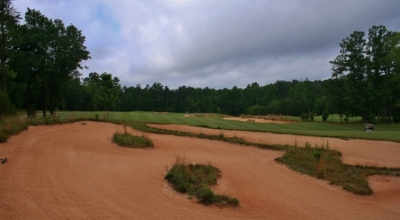 |
| It will not take long to discover the most prominent feature at Lonnie Poole: its waste bunkers. Here, on the par five 1st hole. |
Brandon Johnson (Senior Golf Course Architect and co-project manager at Lonnie Poole along with Erik Larsen) graduated from NC State (as did Larsen), and he said the fact that the end result was to be a university course factored into their thinking on the project. “We knew that various skill levels would be playing the course, so we wanted to allow for various set-up options – everyday play vs. tournament play.”
“We also wanted to incorporate a “home field” advantage to the NCSU golf team. We tried to inject a subtle layer of strategy that might only be discovered after multiple plays (slopes, features, pin locations and angles of approach) that only the golf team might know from their practice sessions on the golf course,” Johnson said proudly.
Alas, local knowledge does have its privileges. Having only played Lonnie Poole once, it’s hard to say where all the best strategic angles would be – though the course certainly offers a multitude of options in terms of variety of tees, pin placements on large greens, and wide playing areas so you can choose a line of attack.
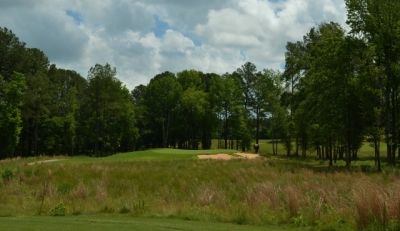 |
| Trouble abounds on the par three 14th hole, but the green complex is actually large and accommodating. |
The nature of the ground offered up plenty of opportunities for variety. Again, Johnson expounds: “We had a beautiful piece of property to work with. Mature pines and hardwoods dominated one portion of the property while a more native grass/open meadow area was the theme in the center of the site. Then there were long, broad, and flowing contours that we affectionately called ‘The Big Roll’ that added spice and charm to the site.”
He continues, “We also had a few challenges to consider. The first constraint was nature. Several large drainage swales, created by our ‘Big Roll,’ connected to the Neuse River Basin and buffer. We were not allowed to clear or cross these creek beginnings with the golf holes and had to receive special permission to install select bridge crossings.”
“The other two main constraints were manmade. The first being a pre-existing detention basin that we could not touch, move or manipulate. The second being a future interstate exchange that was previously incorporated into the Centennial Campus master plan. It bisected the site and two green to tee relationships. These ultimately factored into the final routing of the golf course,” Johnson explained.
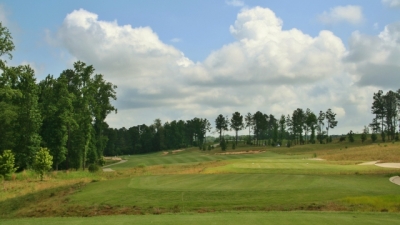 |
| The par four 9th hole is long and challenging. |
It’s nice to know there were some difficulties in laying out Lonnie Poole – nothing that’s worthwhile is ever easy. The property does have a very wide-open feel to it, helped along by the course’s enormous waste bunkers. It’s the first thing you’ll notice when looking at the golf holes.
According to Lonnie Poole’s General Manager, Chip Watson, that too, was by design. “Our bunkers have irregular shapes and jagged edges, because geometric shapes are rarely seen in natural landscapes. Instead of defined edges, islands and peninsulas with fine fescues intersect and blend with the roughs.”
It certainly presents somewhat of a rugged appearance – and is fairly intimidating.
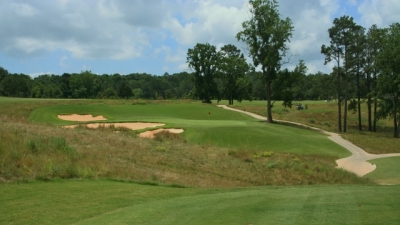 |
| The par three 17th is short - 135 yards from the back tee - but its green is sloped and very ready to defend par. |
It needn’t be, according to Watson. He says the bunkers are actually more playable than fescue roughs. “Shots landing in the sand will provide easier recovery than the tall grass, which often requires a drop and an extra stroke. The sand in the bunkers is stained by natural erosion from the edges – again, by design.”
“The course is located in the North Carolina Piedmont, which has clay soils. How can a natural setting be pure white?”
Watson has a point. White sand bunkers wouldn’t look right at Lonnie Poole. It’s all natural, in the tradition of other courses with large waste areas, such as Bethpage Black, Bandon Dunes, Whistling Straits, and Pine Valley.
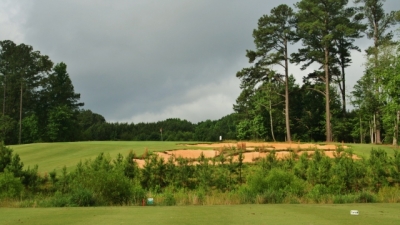 |
| The par five 3rd is the #1 handicap hole at Lonnie Poole - mostly because of the difficulty of the approach shot to a green on top of a slope. |
Yet another unique aspect of Lonnie Poole is the grasses – yes, you heard that right. You’d never guess that so much thought would go into what kind of green stuff to use on a golf course, but these days, everything’s planned out for a reason. Even the shady vs. sunny areas were taken into consideration at Lonnie Poole.
“The course has well known turfgrass species as its heart -- 419 bermudagrass on the fairways and an A1/A4 creeping bentgrass mix on the greens,” Watson said. “The tee boxes are bermudagrass in full sun exposure and Zion or Zorro zoysiagrass if shaded. These are relatively new, fine bladed zoysiagrass types. The bunkers are outlined with El Toro, Zion, or Zorro zoysiagrass to provide visual definition and low maintenance edges.”
Not to be outdone in turfgrass complexity, the roughs are a mixture of four fine fescue species in place throughout the golf course – and typically take a couple seasons to grow in. They’re planted with a mixture of cool and warm season grasses that will adapt to the North Carolina environment and have low resource and maintenance requirements.
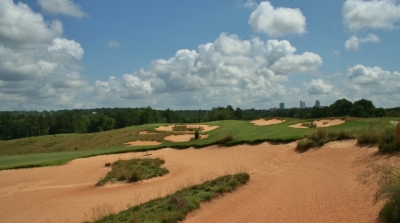 |
| The long par five 11th hole offers a breathtaking view of the Raleigh skyline. |
They’ll also present a color contrast with the fairways and tees. In summer, the mature fescue in the rough will be dominated by tans and browns compared to the vivid greens of bermudagrass and zoysiagrass. The reverse is true in winter, when roughs will be green and dormant bermudagrass and zoysiagrass will be tan.
It should be noted that Lonnie Poole is still a relatively young course (construction started in 2007 and it opened in 2009), and will take some time to reach peak condition. Everything is well grown-in, but several more years of maturity will make it even better.
In addition to hosting NC St.’s men’s and women’s varsity golf teams, Lonnie Poole also serves as a “laboratory” for turfgrass and storm water research associated with the College of Agriculture and Life Sciences for the university. Likewise, the course is a teaching and training facility for the Professional Golf Management Program in the College of Natural Resources.
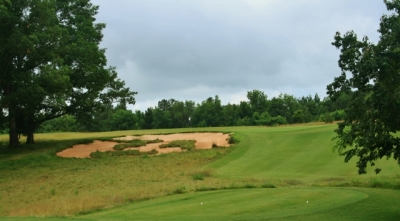 |
| The short par three 6th hole is guarded by sand and trees. |
Now that’s the kind of classroom I like best.
And who is Lonnie Poole? He’s an NC St. alum, of course, who donated $3 million to the project. Poole is the founder and chairman of the board of Raleigh-based Waste Industries USA.
Beyond the interesting story of the course and what it’s used for is the playing of the golf holes. As noted before, strategy’s the word, and Lonnie Poole is definitely a thinking player’s golf course. Johnson says the strategic philosophy of Palmer Course Design has evolved over the years, and it’s well represented at his alma mater.
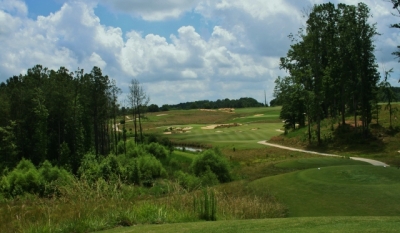 |
| Most of the challenge on the par four 16th hole is on the tee shot, but there is plenty of sand around the green, too. |
Johnson describes it: “The use of contour and slopes to affect the ball on the ground, allow multiple avenues of attack off the tee and into the greens, the ability to access pin locations by hitting the ball away from an intended target or incorporating slopes (subtle and bold) that shed the ball away from your target or green and leaving the player with several different recovery options are just a few of the strategic themes you might find at Lonnie Poole.”
He continues, “We also tried to use width has a strategic feature. Several holes have almost oversize fairways or landing areas that could lull the player into a false sense of security. At first glance, off the tee it might seem that any spot in the fairway might be ideal, but in reality, depending on the day’s pin location, an over-hanging tree limb -- or the effect of the “Big Roll” -- the ideal line might be from the extreme left or right portions of the fairway.”
As mentioned above, there are also a variety of green sizes, shapes and contours on the course.
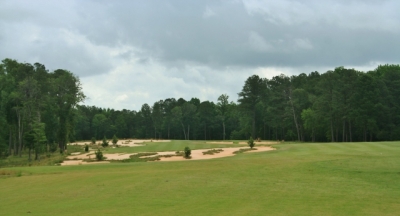 |
| Pull it left off the tee of the par five 7th hole and you might have trouble reaching the green in regulation. |
But just don’t ask Johnson about a “signature” hole – they’re all special in his mind. “This is a common question that we get asked from time to time. Our intention at Lonnie Poole -- and with all our other projects -- is to design 18 holes that are fun to play and offer a variety of strategic challenge and aesthetic interest. We will let everyone else decide what might be their favorite or ‘Signature’ hole.”
“For the reasons stated above, and others, some of my favorite holes at Lonnie Poole are #5 (par four), #7 (par five), #8 (par three) and #16 (par four). The view of the Raleigh Skyline from #11 is pretty good too,” Johnson said.
Our favorites included the par three second hole, primarily because of its unique two-tiered green – with the second tier in the back. It plays 235-yards from the competition tees, but comes down to a more manageable 186-yards from the white (Wolfpack) tees. The hole does go slightly downhill – but if you’re on the wrong part of this green, you’ll definitely remember it.
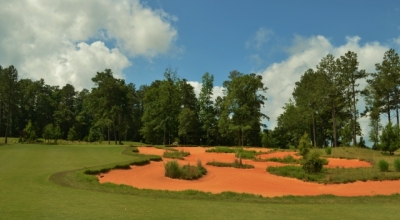 |
| The par four 10th hole provides plenty of putting surface, but from here, it looks like sand dominates the landscape. |
The third hole was once a par four, but was stretched to a par five when new tee boxes opened up farther back. This is one where local knowledge will certainly help, as the most daunting challenge is the approach to the green. If you’re going to go for it in two, you’d better be able to hit it high and long – as there’s a natural area to clear and the green’s at the top of a slope (with a false front, too).
Short but sweet is the par three sixth hole, which plays uphill and is guarded in front by a bunker and on the left by a large tree. Watch out if the pin’s in the back left section of the green…
On the back, Johnson mentioned the views from the par five 11th hole – the best on the course. You can see the NC St. campus as well as downtown Raleigh from the entire length of this hole. The golf’s not bad either, as this 600-yard plus monster demands thought and strategy on how to beat it.
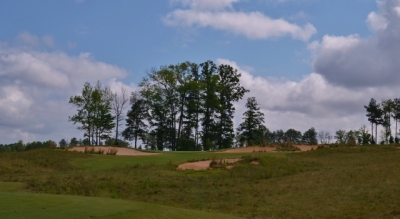 |
| The par three 8th hole goes slightly uphill, and offers plenty of trouble between you and the flagstick. |
The par four sixteenth hole is another highlight, because of its downhill tee shot to a fairway guarded by three bunkers – though it would take quite a poke to reach two of them. It’s just a short-iron from there, but if you’re short, you’ll likely be in the sand.
It’s safe to say that Palmer Course Design gives loving care to all its golf courses, but Johnson says Lonnie Poole will always have a special place in his heart. “Having the opportunity to return to the University that provided me with the tools and opportunity to realize my dream of becoming a golf course architect is obviously very special.”
“Anyone who knows me knows that I love food, so eating at the Farmer’s Market across the street during site visits was a treat. We also made some very strong friendships and had tons of laughs during the course of the project,” Johnson concluded.
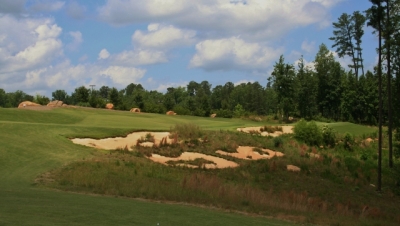 |
| Coming home on the par four 18th hole, you can certainly play the slope on the left side of the green to avoid going right. |
Lonnie Poole Golf Course is obviously a welcome addition to the Raleigh area, and will most definitely continue providing a terrific golf experience to the NC St. campus community and visitors for years to come.
Where we Stayed
The Hilton Garden Inn Durham Southpoint hotel is conveniently located off I-40 and within close proximity to Durham, Chapel Hill and RDU International Airport. Across from The Streets at Southpoint mall, the hotel is loaded with amenities for the comfort of all guests. Its rooms are furnished with a spacious work desk and Herman Miller Mirra® ergonomic desk chair, two phones, voicemail and complimentary wired and wireless high-speed internet access. Standard in every room is a 32-inch LCD HD TV, along with a hospitality center complete with microwave, refrigerator and coffee maker. Call 919-544-6000 or visit http://hiltongardeninn3.hilton.com/en/hotels/north-carolina/hilton-garden-inn-durham-southpoint-RDUSPGI/index.html
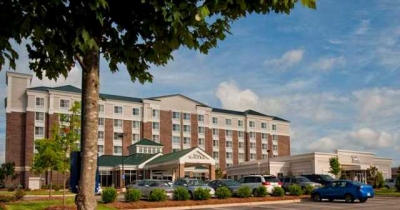 |
Note: We would especially like to commend the staff at the hotel, which went out of their way on several occasions to make our stay comfortable and relaxing. When combined with the hotel’s central location to a number of great courses in the Triangle area, it’s an excellent place to stay for golfers visiting North Carolina.
Summit Hospitality owns and operates 15 hotels in the Triangle, Charlotte, Pinehurst and Wilmington as a franchisee of Marriott, Hilton and Hyatt brands. It also offers golf packages at various properties. www.SummitHospitality.com
Details:
Lonnie Poole Golf Course at NC State University
1509 Main Campus Drive
Raleigh, NC 27606
Phone: 919/833-3338
Website: www.lonniepoolegolfcourse.com
General Manager: Chip Watson
Course Designer: Arnold Palmer Course Design
(With Brandon Johnson and Erik Larsen project managers)
Tees/Yardage/Slope/Rating
Competition: 7358 145/74.8
Black 6916 138/72.9
Red 6502 130/70.7 147/76.9 (W)
Wolfpack 6027 127/68.4 140/74.3 (W)
Gray 5508 116/66.2 130/71.6 (W)
Pink 4869 106/63.5 121/68.2 (W)
Notes and Rates:
You make walk at anytime, no restrictions.
Monday through Thursday:
Public: $49.00
Staff/Faculty: $39.00
Students: $35.00
Replays: $25.00
Twilight: $35.00 (carts in 15 minutes before dusk)
Friday through Sunday and Holidays:
Public: $75.00
Staff/Faculty: $60.00
Students: $54.00
Replays: $35.00
Twilight: $45.00 (carts in 15 minutes before dusk)
| Related Links | Comments on this article? | |
|
Maryland National Golf Club Hollow Creek Golf Club Rocky Gap Resort PB Dye Golf Club in Ijamsville Whiskey Creek Golf Club |
E-mail Jeff Rendall, Editor: jrendall@golftheunitedstates.com |












